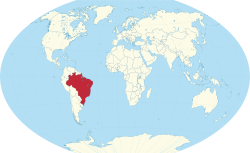Biology:Nymphaea paganuccii
| Nymphaea paganuccii | |
|---|---|
| Scientific classification | |
| Kingdom: | Plantae |
| Clade: | Tracheophytes |
| Clade: | Angiosperms |
| Order: | Nymphaeales |
| Family: | Nymphaeaceae |
| Genus: | Nymphaea |
| Species: | N. paganuccii
|
| Binomial name | |
| Nymphaea paganuccii C.T.Lima & Giul.[1]
| |

| |
| Nymphaea paganuccii is endemic to Brazil[1][2] | |
Nymphaea paganuccii is a species of waterlily endemic to Brazil.[1][2]
Description
Vegetative characteristics
Nymphaea paganuccii is an aquatic herb.[2] It has cylindrical tubers, which are not stoloniferous. The glabrous, green, non-brittle petioles have four primary central and four secondary peripheral air canals.[3] The elliptic, suborbicular to orbicular leaf blade has a flat and entire margin.[2] The blade is 15.3–19.8 cm long and 10–17.3 cm wide.[3]
Generative characteristics
The nocturnal flowers float on the water surface.[2] The non-brittle, brownish, glabrous peduncle has six primary central and 12 secondary peripheral air canals.[3] The ovoid, smooth, pilose seeds have trichomes arranged in continuous longitudinal lines.[2] The seeds are 1–1.2 mm long and 0.7–0.8 mm wide.[3]
Reproduction
Vegetative reproduction
Both stolons and proliferating pseudanthia are absent.[3][2]
Generative reproduction
Flowering and fruiting has been observed in the month of July. Sexual reproduction plays a significant role in this species.[3]
Taxonomy
It was first described by C.T.Lima and Ana Maria Giulietti in 2021.[1]
Type specimen
The type specimen was collected by C.T. Lima and L. Lima at depths of 1-3 m in a lagoon by the Tapajós river of the Santarém municipality in the state Pará, Brazil on the 18th of July 2011.[3]
Placement within Nymphaea
It is placed in Nymphaea subgenus Hydrocallis.[3]
Etymology
The specific epithet paganuccii honours Prof. Dr. Luciano Paganucci de Queiroz of the State University of Feira de Santana, Brazil.[3]
Ecology
Habitat
It occurs in the aquatic habitats of the Amazon rainforest.[2] The depth of the lagoon habitat in the type locality fluctuates based on precipitation in the region, with a complete dry period occurring between August and December. It occurs sympatrically with several other Nymphaea species, namely Nymphaea amazonum, Nymphaea pedersenii, Nymphaea rapinii, and Nymphaea lingulata. [3]
Pollination

Beetles of the genus Cyclocephala visit the flowers of Nymphaea paganuccii and have been trapped within them, indicating pollination by these beetles.[3]
References
- ↑ 1.0 1.1 1.2 1.3 "Nymphaea paganuccii C.T.Lima & Giul." (in en). Royal Botanic Gardens, Kew. http://www.plantsoftheworldonline.org/taxon/77295793-1. Retrieved 17 December 2023.
- ↑ 2.0 2.1 2.2 2.3 2.4 2.5 2.6 2.7 Pellegrini, M. O. O. & Jardim Botânico do Rio de Janeiro. (n.d.-b). Nymphaea paganuccii C.T.Lima & Giul. Flora E Funga Do Brasil. Retrieved December 17, 2023, from https://floradobrasil.jbrj.gov.br/FB623384
- ↑ 3.00 3.01 3.02 3.03 3.04 3.05 3.06 3.07 3.08 3.09 3.10 3.11 de Lima, C. T., Machado, I. C., & Giulietti, A. M. (2021). "Nymphaeaceae of Brasil." Sitientibus série Ciências Biológicas, 21.
Wikidata ☰ Q123905483 entry
 |

